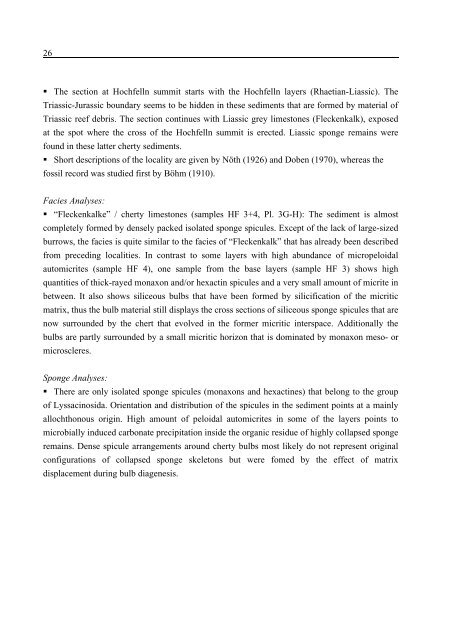Porifera-microbialites of the Lower Liassic (Northern Calcareous ...
Porifera-microbialites of the Lower Liassic (Northern Calcareous ...
Porifera-microbialites of the Lower Liassic (Northern Calcareous ...
You also want an ePaper? Increase the reach of your titles
YUMPU automatically turns print PDFs into web optimized ePapers that Google loves.
26<br />
� The section at Hochfelln summit starts with <strong>the</strong> Hochfelln layers (Rhaetian-<strong>Liassic</strong>). The<br />
Triassic-Jurassic boundary seems to be hidden in <strong>the</strong>se sediments that are formed by material <strong>of</strong><br />
Triassic reef debris. The section continues with <strong>Liassic</strong> grey limestones (Fleckenkalk), exposed<br />
at <strong>the</strong> spot where <strong>the</strong> cross <strong>of</strong> <strong>the</strong> Hochfelln summit is erected. <strong>Liassic</strong> sponge remains were<br />
found in <strong>the</strong>se latter cherty sediments.<br />
� Short descriptions <strong>of</strong> <strong>the</strong> locality are given by Nöth (1926) and Doben (1970), whereas <strong>the</strong><br />
fossil record was studied first by Böhm (1910).<br />
Facies Analyses:<br />
� “Fleckenkalke” / cherty limestones (samples HF 3+4, Pl. 3G-H): The sediment is almost<br />
completely formed by densely packed isolated sponge spicules. Except <strong>of</strong> <strong>the</strong> lack <strong>of</strong> large-sized<br />
burrows, <strong>the</strong> facies is quite similar to <strong>the</strong> facies <strong>of</strong> “Fleckenkalk” that has already been described<br />
from preceding localities. In contrast to some layers with high abundance <strong>of</strong> micropeloidal<br />
automicrites (sample HF 4), one sample from <strong>the</strong> base layers (sample HF 3) shows high<br />
quantities <strong>of</strong> thick-rayed monaxon and/or hexactin spicules and a very small amount <strong>of</strong> micrite in<br />
between. It also shows siliceous bulbs that have been formed by silicification <strong>of</strong> <strong>the</strong> micritic<br />
matrix, thus <strong>the</strong> bulb material still displays <strong>the</strong> cross sections <strong>of</strong> siliceous sponge spicules that are<br />
now surrounded by <strong>the</strong> chert that evolved in <strong>the</strong> former micritic interspace. Additionally <strong>the</strong><br />
bulbs are partly surrounded by a small micritic horizon that is dominated by monaxon meso- or<br />
microscleres.<br />
Sponge Analyses:<br />
� There are only isolated sponge spicules (monaxons and hexactines) that belong to <strong>the</strong> group<br />
<strong>of</strong> Lyssacinosida. Orientation and distribution <strong>of</strong> <strong>the</strong> spicules in <strong>the</strong> sediment points at a mainly<br />
allochthonous origin. High amount <strong>of</strong> peloidal automicrites in some <strong>of</strong> <strong>the</strong> layers points to<br />
microbially induced carbonate precipitation inside <strong>the</strong> organic residue <strong>of</strong> highly collapsed sponge<br />
remains. Dense spicule arrangements around cherty bulbs most likely do not represent original<br />
configurations <strong>of</strong> collapsed sponge skeletons but were fomed by <strong>the</strong> effect <strong>of</strong> matrix<br />
displacement during bulb diagenesis.

















